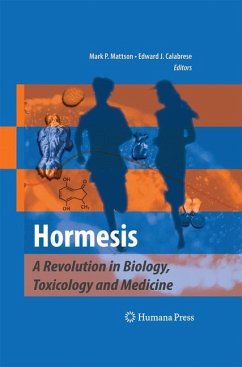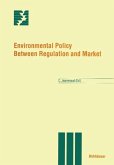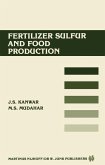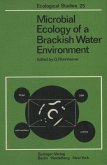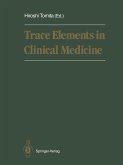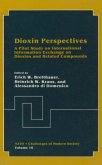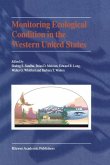Hormesis is defined as any circumstance in which exposure of a cell or organism to a low dose of a substance or condition results in an adaptive stimulatory/beneficial outcome, while exposure to a high dose results in an inhibitory / detrimental outcome. When plotted on a graph the shape of the dose response curve is biphasic, the hallmark of hormesis. This groundbreaking book "Hormesis: A Revolution in Biology, Toxicology and Medicine" describes why and how hormesis is a fundamental feature of all living systems and is based on the evolutionary principle of selection for genetic traits that confer the ability to respond adaptively to adverse environmental conditions. Using numerous specific examples the authors explain why knowledge of hormesis is important for our health, our environment, and the future of our planet. Several chapters of the book describe emerging research findings that elucidate the molecular and cellular underpinnings of the biphasic dose response/hormesis. The implications of the tapping of cellular systems that underlie hormesis for the discovery and optimization of new drugs and dietary formulations are described.
From environmental protection policy to medical practice, it is critical that leaders recognize and understand hormesis, and incorporate it into their decision making process. The authors propose that the prevention of major diseases, including diabetes, obesity and cardiovascular disease can be achieved using hormetic approaches. Scientists, physicians, environmental gurus and anyone interested in the science underlying biology and medicine will benefit from reading this book.
Features
Groundbreaking coverage of an oft experienced, but poorly understood phenomenon that affects all forms of life on earth.
Explains why the principle of hormesis is important to our health, our environment, and the future of our planet.
Provides specific examples of biphasicdose responses and their importance for the fields of biology, medicine and environmental safety.
Discusses how knowledge of hormesis is being applied to research aimed understanding the organization and function of biological systems.
Illustrates how disorders such as diabetes, obesity and cardiovascular disease result from the lack of exposure to beneficial environmental stresses.
Considers the implications of the cellular systems that underlie hormesis for the discovery and optimization of new drugs and dietary formulations.
From environmental protection policy to medical practice, it is critical that leaders recognize and understand hormesis, and incorporate it into their decision making process. The authors propose that the prevention of major diseases, including diabetes, obesity and cardiovascular disease can be achieved using hormetic approaches. Scientists, physicians, environmental gurus and anyone interested in the science underlying biology and medicine will benefit from reading this book.
Features
Groundbreaking coverage of an oft experienced, but poorly understood phenomenon that affects all forms of life on earth.
Explains why the principle of hormesis is important to our health, our environment, and the future of our planet.
Provides specific examples of biphasicdose responses and their importance for the fields of biology, medicine and environmental safety.
Discusses how knowledge of hormesis is being applied to research aimed understanding the organization and function of biological systems.
Illustrates how disorders such as diabetes, obesity and cardiovascular disease result from the lack of exposure to beneficial environmental stresses.
Considers the implications of the cellular systems that underlie hormesis for the discovery and optimization of new drugs and dietary formulations.
From the reviews:
"'Hormesis: a revolution in biology, toxicology and medicine' is a very interesting and well- written book organized by two expressive authors in neuroscience and the health environment. ... The book is divided into 10 chapters, each written by a group of authors, describing the concept of hormesis ... . book concludes by proposing a fresh look at the modern pharmacy of natural products and man-made drugs. It is a pleasant read for anyone interested in toxicology, environmental health and pharmacology." (Tania Marcourakis, Brazilian Journal of Pharmaceutical Sciences, May, 2010)
"This book argues that hormesis (biphasic dose-response patterns) is an underlying process at all levels of biological organization. ... The book appears to be written for risk assessors and researchers interested in dose-response relationships and cellular signaling pathways. ... Physically, the book is nicely laid out with high-quality illustrations that enhance the text. The concept of the hormetic dose-response curve is worth further study, and may well lead to advances in pharmacology and other biomedical applications." (Jennifer Gervais, Doody's Review Service, February, 2011)
"'Hormesis: a revolution in biology, toxicology and medicine' is a very interesting and well- written book organized by two expressive authors in neuroscience and the health environment. ... The book is divided into 10 chapters, each written by a group of authors, describing the concept of hormesis ... . book concludes by proposing a fresh look at the modern pharmacy of natural products and man-made drugs. It is a pleasant read for anyone interested in toxicology, environmental health and pharmacology." (Tania Marcourakis, Brazilian Journal of Pharmaceutical Sciences, May, 2010)
"This book argues that hormesis (biphasic dose-response patterns) is an underlying process at all levels of biological organization. ... The book appears to be written for risk assessors and researchers interested in dose-response relationships and cellular signaling pathways. ... Physically, the book is nicely laid out with high-quality illustrations that enhance the text. The concept of the hormetic dose-response curve is worth further study, and may well lead to advances in pharmacology and other biomedical applications." (Jennifer Gervais, Doody's Review Service, February, 2011)

